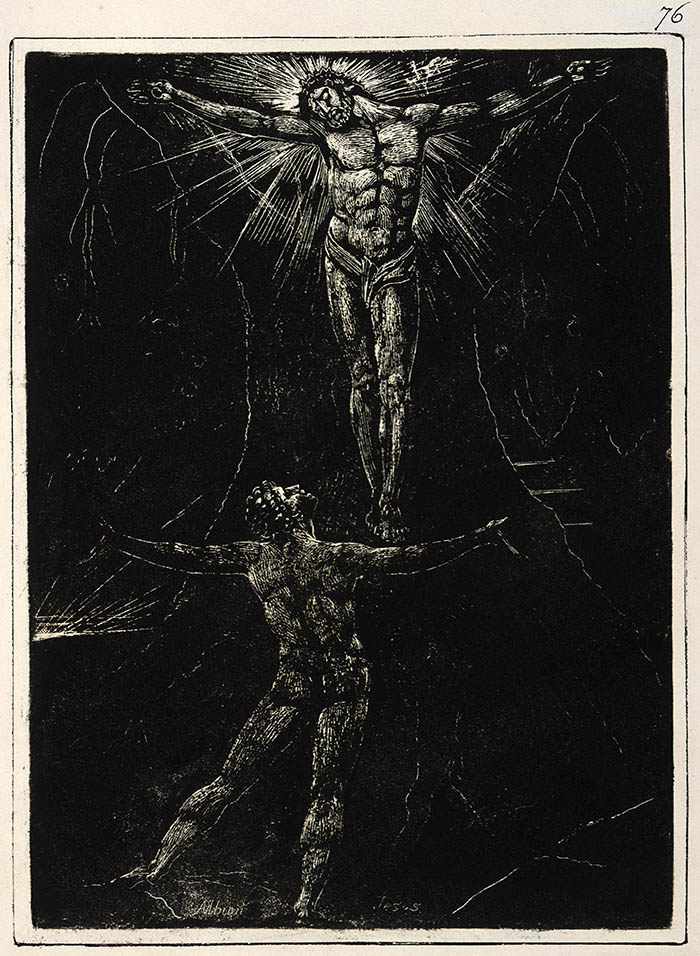 |
British Museum Jerusalem Plate 76 |
CHAPTER SIX
Bible
Images of Grace
For the Christian of course Blake's happiest use of the Bible occurs with his statements of the gospel; these came after his Moment of Grace in 1800. 'The Four Zoas' had been an attempt to organize experience into a pattern of meaning. In the years before grace Blake's concept of redemption rested upon the efforts of Los, the Imagination, to create meaning out of the chaos of fallen life.
This process begins in Night iv and goes on to the end of the poem. Blake called it "building Golgonooza", an adaptation of the biblical drama of rebuilding fallen Jerusalem. Blake took this from the book of Ezra , one of his earliest companions. At the beginning of Night ix, written after the Moment of Grace , Los and Enitharmon are no longer building Golgonooza; now they are building Jerusalem!
In the earlier years salvation for Blake lay in art, as it has for so many sensitive souls before and after his day. Once he met grace, Jesus became for Blake the One and the All. Jesus subsumed Blake's art and redeemed it. He tells us that Jesus appeared to him in "the likeness and similitude of Los".
Kierkegaard spoke of the aesthetic phase. Some aesthetes among Blake's critics, valuing art more highly than Christ, have experienced the change as a deterioration of Blake's art. Christians in contrast see the new work like Blake saw it, as a glorified art, sublimated and fulfilled:
Prayer is the Study of Art.
Praise is the Practise of Art.
Fasting &c., all relate to Art. br ....
Jesus & his Apostles & Disciples were all Artists.
....
The Old & New Testaments are the Great Code of Art.
Art is the Tree of Life.
(Selected Passages from The Laocoon)
These are certainly provocative words! We should know that the Bible is art in its highest form, but never art for art's sake, always art for God's sake. In the Laocoon inscriptions (quoted above) Blake made a frontal attack upon the "aesthetic" orientation by pointing out the identity between true art and true godlinesss, the "Tree of Life", which was God's original intention for man before the serpent snarled up his plans.
It became a special joy and a labor of love for Blake after his conversion to go back and recolor his Biblically inspired myth with those previously discounted parts of the Bible which now burned in his consciousness. Matthew, Mark, Luke and John tell the story of the Lord of Love, adored by thousands who know little or nothing about the rest of the Bible. Blake now puts Jesus at the center, or rather the apex, of his myth of meaning.
The 17th chapter of John is probably the central passage of scripture for Blake's myth, both before and after the Moment of Grace. In it Jesus prays to the Holy Father:
[21] That they all may be one; as thou, Father, art in me, and I
in thee, that they also may be one in us: that the world may believe
that thou hast sent me.
[22] And the glory which thou gavest me I have given them; that they may be one, even as we are one:
[23] I in them, and thou in me, that they may be made perfect in one;
Blake's visionary experience from his earliest days had centered on this image of oneness. All of his reading in the heterodox tradition had reinforced it as the basic shape of reality. The Gnostics, the Neo-platonists, the alchemists, the Cabbalists, the Christian mystics, all had emphasized the supernal oneness of God and Man and life. Blake had seen all trouble and sorrow and brokenness in terms of the fracture and separation or division from the primeval oneness. This was the basic idea of his myth:
"Daughters of Beulah, Sing His fall into Division & his Resurrection to Unity." Four Zoas, Page 4, (E 301)
And now on the sands of Felpham he had met the One, been folded into his bosom and heard himself affectionately named by the One ("Thou Ram Horn'd with Gold"). Turning to scripture with new eyes, irradiated with his First Vision of Light he finds the Saviour praying that we might be one as he is one with the Father.
In the eternal realm the sequence is reversed: the divine prayer had in earliest childhood fallen into the deepest levels of Blake's being. Like the veritable mustard seed it lay there exerting an unconscious force, guiding him to the Gnostics (who knew more about oneness than did the Church Fathers), the Neoplatonists, and the others. And when the soil of Blake's psyche was fully prepared, the seed burst out in the full embodiment of the vision of Light, when for Blake the One became flesh.
This is the center of the Christian faith: that we are one, that we are all Christ's members. Those who deny to Blake the name of Christian on the basis of his 'white' reading of the Bible thereby betray their own off centeredness. Certainly he was no orthodox Christian; orthodox Christianity in its many forms has been way off center. When Blake dreamed of the One and met the One and sang of the One, he imaginatively incarnated the answer to the divine prayer. Is there any better way to be a Christian?
Read more about Blake's Moment of Grace and it's implications.
No comments:
Post a Comment